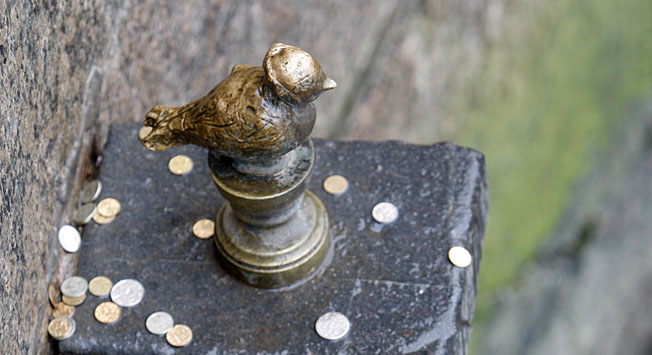Making a wish on a bronze nose: St. Petersburg’s most popular sculptures

I live near the Kupchino metro station where stands a statue of the Good Soldier Svejk. Balkanskaya pl. (Balkan square) connects here with a street named for the Czech writer and author of Svejk’s adventures, Jaroslav Hashek. World War I, the conflict that Hashek’s main character participated in, started on the Balkan Peninsula. Today the brave Czech boozer Svejk who fought against Russia and carried out his duties to the point of absurdity and catastrophe, instead helps the residents of St. Petersburg.
Photo credit: Grigory Kubatian
In the morning when a crowd of citizens runs to work, almost every 10th person touches the soldier on his nose – just in case – to bring a little luck to their day. Over 10 minutes of observing the sculpture, Svejk’s nose was touched not less than 10 times.
A tired woman carrying heavy bags comes up to Svejk and with a sigh and without a smile puts her bags on the ground and rubs the Czech character's nose. After that she goes around the statue and puts something into a beer mug that this bronze and cunning fellow hides behind his back.
“Tell me, is it some kind of a ritual?” I ask her. The woman feels embarrassed and says, “It’s nothing special. People say that he brings good luck. And money. So, I always put a coin in his mug.”
Accessible wonder makers
Russians grab sculptures' noses for luck, shake their hands, pull their ears, tap on their shoulders and sit on their laps. As a result these bronze figures often acquire shiny marks in very unexpected places.
Sometimes such maneuvers are pranks by military cadets who polish the testicles of Peter the Great's horse (I am referring to the famous Bronze Horseman statue), or jokes by students from the Technological Institute who have a soft spot for the schnozzle of the great Russian chemist Dmitry Mendeleev, whose bust stands in front of the chemistry department of the institute. But oftentimes it is the result of true belief in the idea that these speechless statues have wondrous abilities.
Photo credit: Grigory Kubatian
The statues in the city are as distinct from each other as are the more unapproachable sculptures of the famous poet Alexander Pushkin, Soviet leader Vladimir Lenin or Peter I – St. Petersburg’s founder – who are installed on inaccessible pedestals that are under constant watch. However, it is easy to ask for a little bit of happiness from several more accessible urban genre sculptures and hug them for a picture.
The army of tour guides sets the trend. There are about 5,000 licensed guides in St. Petersburg and it is unknown how many more guides work informally. All of them make suggestions to tourists “to rub, so that your dream will come true.” Tourists listen trustfully and rub. What if it is indeed true?
How to clink glasses with a statue
The central character of popular Russian picaresque novels by Ilya Ilf and Yevgeny Petrov “12 chairs” and “The Little Golden Calf,” Ostap Bender, is as lucky as Svejk. Judging it based on its shine, his outstanding nose on its statue on Italianskaya ul. is also believed to be involved in granting wishes. But not only his nose is considered lucky, but so are also the chair from the parlor furniture set, his scarf, a folder with documents and his left heel. All of this shine from rubbing is the work of those that climb onto the statue to make a selfie with the character who knew 400 relatively honest ways of taking money from the population.
Within a 15 minute walk from Ostap Bender on the pedestrian street Malaya Sadovaya ul., there is a monument to photographer Karl Bulla. Do I need to mention that his nose is also holy and an object of worship? There is a pile of change at the photographer's feet. These are lucky pennies left here just like it is common to leave coins in religious places.
Photo credit: Grigory Kubatian
Here, on Malaya Sadovaya ul., on the second floor, there are also figures of cats. On one side of the street there is Yelisey, and on the other – Vasilisa. If you manage to throw your coin up to the cat, you will become lucky, happy and wealthy.
The most popular sculpture object that attracts coins is a bird from a joke song, Chizhik-Pyzhik, installed on the embankment of the Fontanka River, next to Mikhailovsky Palace. Every tourist strives to hit the bird with a coin. They say that the most accurate ones will have their dreams come true with the help of this little bird. Chizhik Pyzhik was even stolen several times, presumably so that it would grant wishes to specific – and not random – people.
Photo credit: RIA Novosti/Vadim Zhernov
“For 15 years in a row now I have been coming to St. Petersburg and every time I come here,” says a black-haired man in glasses. He threw all the change he had in his wallet into the Fontanka Canal. One of the coins landed on Chizhyk's pedestal though, so it means that he can relax and enjoy life until next year.
But reaching the bronze bird is not easy. But some people have thought this through. Newlyweds attach a rope to a shot glass with vodka, lower it down and clink it with the beak. Indeed vodka is a key element in the song about Chizhik: “Chizhik-Pyzhik, where were you? I drank vodka on Fontanka Canal.”
Making dreams come true is the attraction that brings money to tour guides and marketers. But what should an ordinary person who is down on their luck do? There is only one thing left to do – make a wish on a bronze nose.
All rights reserved by Rossiyskaya Gazeta.
Subscribe
to our newsletter!
Get the week's best stories straight to your inbox